TheLostSwede
News Editor
- Joined
- Nov 11, 2004
- Messages
- 18,854 (2.50/day)
- Location
- Sweden
| System Name | Overlord Mk MLI |
|---|---|
| Processor | AMD Ryzen 7 7800X3D |
| Motherboard | Gigabyte X670E Aorus Master |
| Cooling | Noctua NH-D15 SE with offsets |
| Memory | 32GB Team T-Create Expert DDR5 6000 MHz @ CL30-34-34-68 |
| Video Card(s) | Gainward GeForce RTX 4080 Phantom GS |
| Storage | 1TB Solidigm P44 Pro, 2 TB Corsair MP600 Pro, 2TB Kingston KC3000 |
| Display(s) | Acer XV272K LVbmiipruzx 4K@160Hz |
| Case | Fractal Design Torrent Compact |
| Audio Device(s) | Corsair Virtuoso SE |
| Power Supply | be quiet! Pure Power 12 M 850 W |
| Mouse | Logitech G502 Lightspeed |
| Keyboard | Corsair K70 Max |
| Software | Windows 10 Pro |
| Benchmark Scores | https://valid.x86.fr/yfsd9w |
So far, all of the leaked Intel Z690 based motherboards have been void of anything from MSI, but now we get a look at some of their upcoming models courtesy of a couple of different leaks.This gives us a pretty good look at several different market segments from MSI, although none of its really high-end models have leaked yet.
MSI's product stack is a bit cryptic, as we have a pair of MEG boards, one MPG board, one MAG board and a more entry level Pro board. Starting from the bottom working our way up, the Pro Z690-A WiFi appears to be a slightly beefier version of its current Z590-A Pro, with DDR5 support, a pair of 8-pin 12 V EPS connectors, as well as a fourth M.2 slot for NVMe SSDs. We don't spot any real stand-out features on this board, but it looks fairly competent for the market segment.
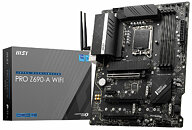
A step up we have the MAG Z690 Tomahawk WiFi DDR4, which is also very close to its Z590 sibling, but has grown a PCIe x4 slot. The SATA port layout is quite odd on this board, with two ports being nestled under the chipset heatsink for no apparent reason. Once again we're looking at an upgrade to two EPS connectors and a total of four M.2 slots.
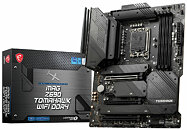
The MPG Z690 Force WiFi is a silvery take of MPG Z590 Gaming Force with what appears to be better heatsinks all around, but otherwise the connectivity looks to have remained mostly the same. It's also the first board where we get a look at the ports, but there's sadly nothing really interesting to see, as the layout is identical to the Z590 board.
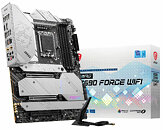
Moving up the stack we have the MEG Z690 Unify-X and here there are some more obvious changes from its Z590 predecessor. First of all we have a pair of x16 PCIe slots, whereas the Z590 version only had one. Gone are the x1 PCIe slots in favour of a fourth M.2 slot, although the open-ended PCIe x4 slot remains. The heatsinks appear to have grown slightly and MSI has dropped the 6-pin power connector on the bottom of the board, although a PS/2 port has made an appearance around the back, alongside a second 2.5 Gbps Ethernet port, at the cost of some USB ports.
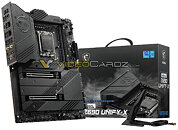
Finally MEG Z690 Unify, which has four rather than the two DIMM slots of the MEG Z690 Unify-X, but otherwise appears to be mostly identical in terms of features and appearance, much as its Z590 sibling. Both the Unify models should be DDR5 boards.
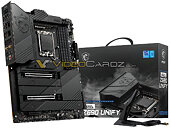
View at TechPowerUp Main Site
MSI's product stack is a bit cryptic, as we have a pair of MEG boards, one MPG board, one MAG board and a more entry level Pro board. Starting from the bottom working our way up, the Pro Z690-A WiFi appears to be a slightly beefier version of its current Z590-A Pro, with DDR5 support, a pair of 8-pin 12 V EPS connectors, as well as a fourth M.2 slot for NVMe SSDs. We don't spot any real stand-out features on this board, but it looks fairly competent for the market segment.

A step up we have the MAG Z690 Tomahawk WiFi DDR4, which is also very close to its Z590 sibling, but has grown a PCIe x4 slot. The SATA port layout is quite odd on this board, with two ports being nestled under the chipset heatsink for no apparent reason. Once again we're looking at an upgrade to two EPS connectors and a total of four M.2 slots.

The MPG Z690 Force WiFi is a silvery take of MPG Z590 Gaming Force with what appears to be better heatsinks all around, but otherwise the connectivity looks to have remained mostly the same. It's also the first board where we get a look at the ports, but there's sadly nothing really interesting to see, as the layout is identical to the Z590 board.

Moving up the stack we have the MEG Z690 Unify-X and here there are some more obvious changes from its Z590 predecessor. First of all we have a pair of x16 PCIe slots, whereas the Z590 version only had one. Gone are the x1 PCIe slots in favour of a fourth M.2 slot, although the open-ended PCIe x4 slot remains. The heatsinks appear to have grown slightly and MSI has dropped the 6-pin power connector on the bottom of the board, although a PS/2 port has made an appearance around the back, alongside a second 2.5 Gbps Ethernet port, at the cost of some USB ports.

Finally MEG Z690 Unify, which has four rather than the two DIMM slots of the MEG Z690 Unify-X, but otherwise appears to be mostly identical in terms of features and appearance, much as its Z590 sibling. Both the Unify models should be DDR5 boards.

View at TechPowerUp Main Site








